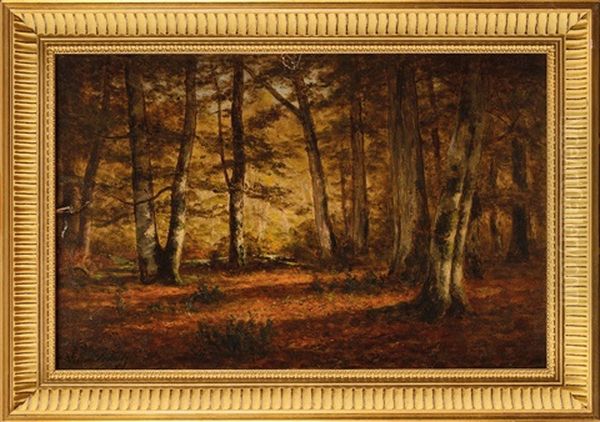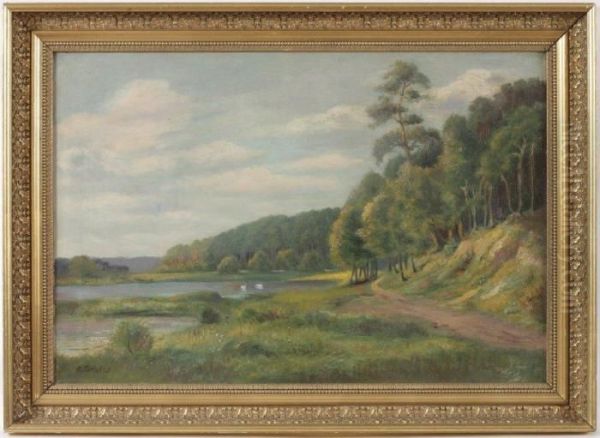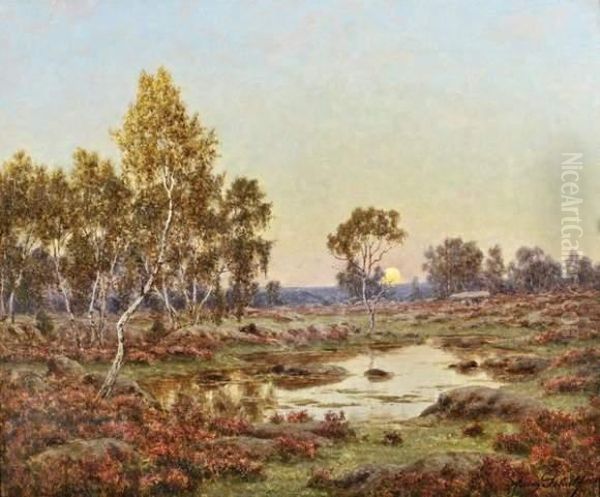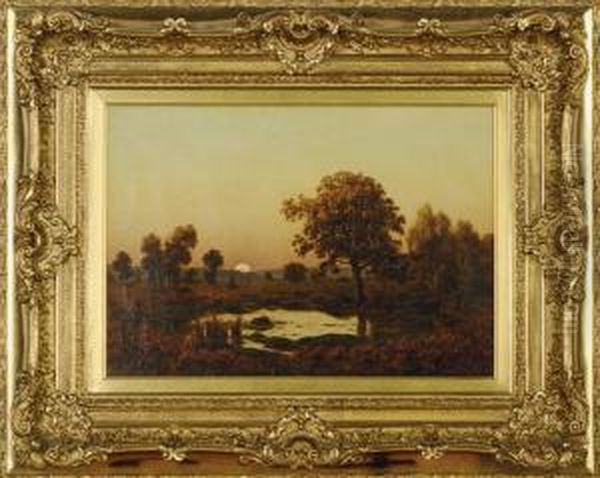Adrien Schulz (1851-1931) was a distinguished French painter whose artistic contributions are primarily associated with the later phase and enduring spirit of the Barbizon School. Working during a period of significant artistic evolution in France, Schulz dedicated his career to capturing the nuanced beauty of the natural world, particularly the landscapes of his native country. His work, characterized by its sensitivity to light, atmosphere, and the tranquil aspects of nature, offers a continuation of the Barbizon painters' revolutionary approach to landscape art, which prioritized direct observation and a truthful representation of rural scenery over idealized or mythological subjects.
Schulz's oeuvre reflects a deep reverence for the French countryside, often depicting serene forest interiors, quiet riverbanks, and the subtle shifts of seasons. While perhaps not as widely known internationally as the pioneering figures of the Barbizon movement, his paintings are valued for their technical skill, poetic sensibility, and their embodiment of the Barbizon ethos. As an artist active in the late 19th and early 20th centuries, he bridged the established traditions of Realist landscape painting with the emerging currents that would further transform European art.
The Barbizon School: A Revolution in Landscape Painting
To fully appreciate Adrien Schulz's artistic significance, it is essential to understand the Barbizon School, the movement that profoundly shaped his artistic vision. Emerging in the 1830s and flourishing through the 1870s, the Barbizon School was named after the village of Barbizon, France, situated near the Forest of Fontainebleau. This area became a haven for a group of painters who sought to break away from the academic conventions of Neoclassicism and the dramatic emotionalism of Romanticism, which had dominated French art.

These artists were united by a desire to paint landscapes with a newfound naturalism and sincerity. They emphasized direct observation of nature, often sketching outdoors (en plein air) to capture the immediate effects of light and atmosphere, although many larger works were completed in the studio. The Barbizon painters sought to imbue their landscapes with a sense of mood and an honest depiction of rural life and scenery, moving away from the idealized, historical, or mythological landscapes favored by the French Academy. Their work was revolutionary in its focus on the commonplace and the unadorned beauty of the French countryside.
Key figures of the Barbizon School included Théodore Rousseau, often considered one of its leading spirits, whose meticulous and often somber depictions of the Forest of Fontainebleau were groundbreaking. Jean-Baptiste-Camille Corot, while associated with Barbizon, developed a more lyrical and poetic style, famous for his silvery light and soft atmospheric effects. Jean-François Millet focused on the dignity of peasant life, his iconic works like "The Gleaners" and "The Angelus" portraying rural laborers with profound empathy, set against the backdrop of the Barbizon landscape.
Other prominent members included Charles-François Daubigny, known for his tranquil river scenes often painted from his studio boat, "Le Botin," which allowed him to capture the fleeting effects of water and sky. Narcisse Virgilio Díaz de la Peña was celebrated for his richly colored and textured forest interiors, often dappled with sunlight, and sometimes featuring mythological figures or gypsies. Jules Dupré contributed powerful and dramatic seascapes and landscapes, while Constant Troyon excelled in painting animals within natural settings, bringing a robust realism to his subjects. These artists, each with their individual style, collectively forged a new path for landscape painting in France.
Adrien Schulz: Life and Artistic Development
Adrien Schulz was born in Paris in 1851, a city that was then the undisputed center of the European art world. His formative years coincided with the peak of the Barbizon School's influence and the rise of Realism, championed by artists like Gustave Courbet. While specific details about Schulz's early training are not extensively documented in widely accessible sources, it is evident from his work that he absorbed the prevailing artistic currents, particularly the Barbizon painters' dedication to nature.
It is highly probable that Schulz received formal artistic training, as was customary for aspiring painters of his time, possibly at one of the Parisian academies or under the tutelage of an established master. His choice to specialize in landscape painting, and his stylistic affinity with the Barbizon School, suggests a deep admiration for its pioneers. He would have been well aware of their struggles for recognition and their ultimate success in shifting the focus of French landscape art.

The Forest of Fontainebleau, the spiritual home of the Barbizon painters, undoubtedly became a significant site of inspiration for Schulz, as it was for so many artists before him. His paintings often evoke the quietude and intimate beauty of such woodland environments. He also frequently depicted river scenes, capturing the reflective qualities of water and the lush vegetation along the banks, reminiscent of Daubigny's favored subjects but interpreted through Schulz's own sensibility.
Throughout his career, Schulz remained committed to the principles of naturalistic landscape painting. He exhibited his works regularly, most notably at the Salon des Artistes Français, the official art exhibition of the Académie des Beaux-Arts in Paris. Participation in the Salon was crucial for an artist's reputation and commercial success during this period. His consistent presence there indicates a sustained career and a degree of recognition within the French art establishment of his time. He continued to paint into the early 20th century, passing away in 1931, having witnessed further radical changes in the art world, including the advent of Impressionism, Post-Impressionism, and various Modernist movements.
The Essence of Schulz's Art: Style and Subject Matter
Adrien Schulz's artistic style is deeply rooted in the Barbizon ethos of truth to nature. His paintings are characterized by a careful observation of the natural world, rendered with a subtle and often muted palette that effectively captures the specific atmospheric conditions of a scene. He demonstrated a keen understanding of light and shadow, using them to create depth and mood in his compositions. Unlike the Impressionists who would follow, Schulz's brushwork, while not overly polished, generally aimed for a more finished and descriptive quality, typical of the Barbizon tradition.
His subject matter predominantly revolved around the French landscape. Forest interiors were a common theme, where he explored the interplay of light filtering through leaves, the textures of tree bark, and the secluded, tranquil atmosphere of the woods. These works, often titled with general descriptions such as "<em>Sous-bois en automne</em>" (Autumn Underwood) or "<em>Clairière en forêt</em>" (Forest Clearing), convey a sense of immersion in nature. Schulz was adept at capturing the different seasons, from the fresh greens of spring to the rich russets and golds of autumn, and the stark beauty of winter.

River scenes also feature prominently in his oeuvre, with works like "<em>Bord de rivière</em>" (Riverbank) or "<em>Paysage au bord de l'eau</em>" (Waterside Landscape). In these paintings, Schulz often focused on the calm, reflective surfaces of water, the lush vegetation along the banks, and the gentle undulation of the terrain. Small boats, figures engaged in quiet activities like fishing, or distant village views sometimes populate these scenes, adding a human element without detracting from the dominance of nature. His compositions are typically well-balanced, inviting the viewer to peacefully contemplate the scene.
Schulz's approach was less about dramatic grandeur and more about finding beauty in the ordinary, intimate aspects of the landscape. His work often evokes a sense of serenity and a quiet appreciation for the enduring qualities of the natural world. This focus on the poetic and tranquil elements of nature aligns him closely with the more lyrical side of the Barbizon tradition, as seen in certain works by Corot or Daubigny, though Schulz maintained his own distinct artistic voice.
Notable Works and Exhibitions
While a comprehensive, universally recognized list of Adrien Schulz's most famous individual masterpieces might be less defined than those of the Barbizon pioneers, his body of work consistently reflects his dedication to landscape painting. His paintings are often identified by descriptive titles that indicate their subject matter, such as "<em>Forêt de Fontainebleau</em>," "<em>Paysage de rivière avec pêcheur</em>" (River Landscape with Fisherman), or "<em>Soleil couchant sur la campagne</em>" (Sunset over the Countryside). These titles underscore his commitment to capturing specific locations and moments in nature.
The quality and appeal of his work are evident in its presence in various private and public collections, particularly in France. His paintings continue to appear in art auctions, where they are appreciated by collectors of 19th and early 20th-century French landscape art. The recurring themes in his work – tranquil forests, reflective rivers, pastoral countryside scenes – demonstrate a consistent artistic vision and a mastery of his chosen genre.

As mentioned, Adrien Schulz was a regular exhibitor at the Salon des Artistes Français. This annual event was the most important venue for artists to showcase their work to the public, critics, and potential buyers. His participation over many years signifies a professional career recognized by his peers and the art institutions of his time. While specific awards or critical reviews from these Salon exhibitions might require deeper archival research, his continued acceptance into these prestigious shows speaks to the perceived quality and appeal of his paintings. His work would have been seen alongside that of many other prominent artists of the era, contributing to the rich tapestry of French art at the turn of the century.
Context and Contemporaries: A Network of Influences
Adrien Schulz operated within a vibrant and evolving artistic milieu. The Barbizon painters, whose influence was paramount for him, had already established landscape painting as a significant genre in its own right. Figures like Théodore Rousseau, with his profound connection to the Forest of Fontainebleau, and Jean-Baptiste-Camille Corot, with his poetic and light-filled canvases, set a high standard. Charles-François Daubigny's innovative approach to capturing riverine landscapes directly from his boat also provided a powerful precedent. Schulz would have looked to these masters, and others like Narcisse Virgilio Díaz de la Peña and Jules Dupré, for inspiration and guidance.
The influence of earlier landscape traditions was also part of the artistic air Schulz breathed. The Dutch Golden Age masters of the 17th century, such as Jacob van Ruisdael and Meindert Hobbema, had long been admired for their realistic and atmospheric depictions of their native landscapes. In England, John Constable and J.M.W. Turner had, in the early 19th century, revolutionized landscape painting with their emphasis on direct observation, the study of weather effects, and expressive brushwork. These international developments contributed to the broader elevation of landscape art.
The Realist movement, spearheaded in France by Gustave Courbet, also shared common ground with the Barbizon School in its rejection of academic idealism and its focus on depicting contemporary life and scenery with unvarnished truth. Courbet's bold and often provocative paintings challenged artistic conventions and paved the way for greater freedom of expression. While Schulz's work was generally more serene and less overtly political than Courbet's, the underlying commitment to realism was a shared principle.
Crucially, the legacy of the Barbizon School, which Schulz helped to perpetuate, extended directly to the nascent Impressionist movement. Artists like Claude Monet, Camille Pissarro, Alfred Sisley, and Pierre-Auguste Renoir were all deeply influenced by the Barbizon painters in their early careers. They admired the Barbizon artists' commitment to outdoor painting, their study of light effects, and their choice of everyday landscape subjects. Monet, for instance, acknowledged his debt to Daubigny and Eugène Boudin. Pissarro was a great admirer of Corot. The Impressionists would take these principles further, developing a more radical approach to capturing fleeting moments and sensory perceptions with broken color and visible brushstrokes, but the foundation laid by Barbizon was indispensable. Schulz, working contemporaneously with the rise of Impressionism, thus occupied an interesting position, upholding the Barbizon tradition while witnessing this new artistic revolution. Other notable landscape painters of the era who explored similar themes, though perhaps with different stylistic nuances, included Henri Harpignies, a contemporary who also specialized in naturalistic French landscapes and was influenced by Corot, and Léon Germain Pelouse, known for his atmospheric depictions of the Normandy and Brittany countryside.
Schulz's Enduring Legacy
Adrien Schulz's contribution to French art lies in his steadfast dedication to the principles of the Barbizon School and his ability to create landscapes of enduring beauty and tranquility. While he may not have been an innovator on the scale of the first-generation Barbizon masters or the Impressionists who followed, he was a skilled and sensitive interpreter of the French countryside, producing a body of work that consistently reflects a deep love and understanding of nature.
His paintings serve as a valuable link in the chain of French landscape tradition, demonstrating the lasting appeal of the Barbizon approach well into the era of Modernism. For art lovers and collectors who appreciate the subtle charms of naturalistic landscape painting, Schulz's work offers a rewarding experience. His depictions of forest glades, peaceful rivers, and rural vistas provide a calming antidote to the complexities of modern life, inviting viewers to pause and appreciate the quiet majesty of the natural world.
The continued presence of his works in collections and their appearance on the art market attest to a sustained appreciation for his artistic skill and the serene vision he presented. He represents a significant group of artists who, while perhaps not always in the brightest spotlight of art history, played a crucial role in maintaining and developing important artistic traditions. His art reminds us of the profound connection between artists and their environment, and the timeless human desire to capture and share the beauty of the world around us.
Conclusion
In conclusion, Adrien Schulz stands as a noteworthy figure in the lineage of French landscape painting. As an inheritor and practitioner of the Barbizon tradition, he skillfully captured the essence of the French countryside, creating works characterized by their naturalism, sensitivity to atmosphere, and poetic charm. His life (1851-1931) spanned a period of immense artistic change, yet he remained true to his artistic convictions, focusing on the intimate and tranquil beauty of nature.
While working in the shadow of giants like Corot, Millet, and Rousseau, and contemporaneously with the revolutionary Impressionists such as Monet and Pissarro, Schulz carved out his own niche. His paintings of forest interiors and river scenes, regularly exhibited at the Paris Salon, found appreciation in his time and continue to be valued today. He contributed to the rich tapestry of 19th and early 20th-century art, upholding the values of careful observation and sincere representation that were the hallmarks of the Barbizon School. Adrien Schulz's legacy is one of quiet dedication to his craft and a profound, beautifully expressed love for the landscapes of France.